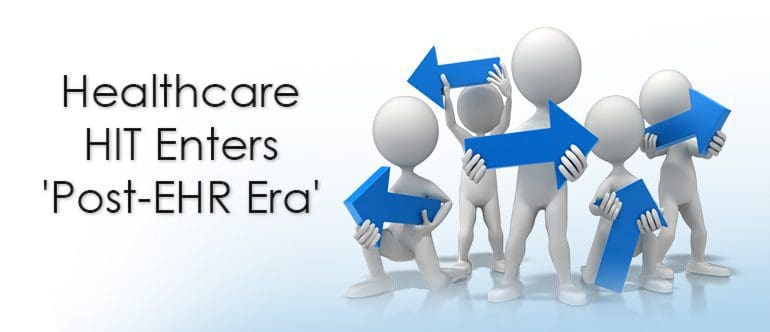Call us toll-free: 800-878-7828 — Monday - Friday — 8AM - 5PM EST

By John Commins for HealthLeaders Media
A drop in the percentage of IT budgets that is directed toward electronic health records systems signals a shift in focus. Now it’s on broader business problems and on operational efficiencies, research suggests.
Hospital health information technology budgets are still growing, but the focus has shifted from meaningful use benchmarks and big electronic medical records projects toward business analytics, mobile services, and cloud-based technologies, a new survey shows.
Judy Hanover, research director for IDC Health Insights, the Framingham, MA-based research firm that conducted the survey, says hospitals have entered a “post-EHR, post-Meaningful Use era.”
“There’s a lessening of focus on EHR” and a redirecting of focus “on the full scope of the IT strategy,” Hanover says.
“We had this period of broad investment between when the meaningful use incentives were announced in 2009 until about 2013/2014. [That’s when] we really saw a laser focus on EHR as a way to meet the need for meaningful use requirements and as a focus and primary goal of health systems when they were directing most of their new investment in IT toward EHR projects and related infrastructure.”
“When we talk about post-EHR, we’ve seen this drop in the percentage of the IT budget that is directed toward EHR. We’ve seen the focus of IT being on broader business problems, on operational efficiencies, things like that,” Hanover says.
“This started to happen for some organizations in 2013, but it’s really in 2015 that we really saw systems turn the corner. They were looking at IT more holistically. They were looking at broader strategies for meeting the goals of healthcare reform. While EHR was still definitely one part of those strategies, it wasn’t the whole focus.
The survey, which focuses on acute care hospitals with 200 or more beds, found that:
- Providers are using more cloud implementations and leveraging mobile and analytics capabilities in the cloud. While 50% of software spending growth is still for on-site investments, survey respondents said 18% of new software spend is going into software-as-a-service (SaaS) and 24% is going into projects hosted by a third party.
- 30% of the respondents said they were comfortable with cloud in 2014 and another 41.5% respondents said they were more comfortable with cloud in 2015 than they were in 2014. Barriers to cloud adoption, primarily comfort levels with security and compliance, are clearly coming down.
- Top reasons for IT budget growth included the desire to enhance or add analytics, patient engagement, customer relationship management, and security.
- Security strategies are maturing. Cybersecurity is one of the new growth areas in the provider IT budget, and this growth is expected to continue in 2016. While threats remain a cause of concern, there is growing implementation of IT security strategies.
- Analytics continues to be one of the fastest-growing segments of the provider IT budget in 2016 as it has been for several years. Ongoing investment in ACO, clinical, and quality will continue in 2016, but hot areas of new analytics investment reported also include provider and care team performance analytics, as well as analytics that examine referral patterns and other financial analytics areas.
“There are still a lot of issues with regard to productivity, with regard to patient safety, with regard to operational efficiency, and effectiveness. When we solved some problems with EHR we created some other ones,” Hanover says.
‘It Can’t be Untethered’
“What we are seeing now is the acceptance of EHR as part of the hospital. It can’t be untethered. But there are ways we can build infrastructures and other technologies around EHR to get us to the next level. That is what we are talking about here.”
Hanover says the post-EHR era likely will be easier for hospitals than the pre-EHR era.
“The hard part is over, but there are still a lot of changes in the environment,” she says. “We are still only partway through a massive change in the business model that has resulted from healthcare reform. We can expect to see changes to how the healthcare business works in the United States for many years to come. We haven’t solved that yet.”
“In terms of the day-to-day change associated with how providers do their job with EHR versus prior to 2009 without it, that change is pretty much complete,” she says.
“The IT changes going forward are going to make that better. We are seeing a lot of tools and add-ons and new EHRs that are going to make the work flow a lot better, a lot less painful for providers. They are going to automate some things and bring more information into it so it is more of a thinking-and-learning platform for the delivery of care. They are going to fix some of the things that disrupt workflows. There is plenty of change to come.”
Going forward in this post-EHR world, Hanover encouraged hospitals to embrace the platforms they’re using now. “If they going to change platforms in the future, they should rate for real innovation and better technology to reach the market,” she says. “There is a lot of senseless spending to try to find the perfect EHR that doesn’t really exist.”
“Holistically, hospitals should be looking at ways to modernize infrastructure. Providers should be getting familiar with the cloud,” she says. “Those who haven’t should start to get that expertise built up within their team.”
